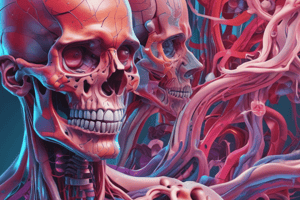Podcast
Questions and Answers
What is the main function of the urinary system in the human body?
What is the main function of the urinary system in the human body?
- Filtering waste products and maintaining fluid balance (correct)
- Facilitating reproduction and the production of offspring
- Breaking down food and absorbing nutrients
- Helping fight infections and maintaining fluid balance
Which region of the human body includes the stomach, intestines, kidneys, and liver?
Which region of the human body includes the stomach, intestines, kidneys, and liver?
- Pelvis
- Chest
- Abdomen (correct)
- Head and neck
Which part of the human body comprises the arms, shoulders, and hands?
Which part of the human body comprises the arms, shoulders, and hands?
- Upper extremities (correct)
- Lower extremities
- Chest
- Pelvis
How many neurons does the human brain have approximately?
How many neurons does the human brain have approximately?
What is the primary function of the lymphatic system?
What is the primary function of the lymphatic system?
What is the role of the skeletal system in the human body?
What is the role of the skeletal system in the human body?
Which system is responsible for enabling movement and generating heat in the body?
Which system is responsible for enabling movement and generating heat in the body?
What is the main function of the endocrine system in the human body?
What is the main function of the endocrine system in the human body?
How are cells organized in the human body to form higher structures?
How are cells organized in the human body to form higher structures?
Which system is responsible for coordinating bodily functions and responses to the environment?
Which system is responsible for coordinating bodily functions and responses to the environment?
Flashcards are hidden until you start studying
Study Notes
Exploring the Wonders of Human Anatomy
Human anatomy is a vast and fascinating subject that delves into the intricate workings of the human body. Dissecting this complex organism into its constituent parts helps us understand the systems that keep us alive and functioning. Let's delve into the basics of human anatomy, focusing on the key aspects of our physiology.
The Body's Building Blocks: Cells and Tissues
The human body is composed of trillions of tiny cells, each performing specialized tasks with precision and coordination. Cells group together to form tissues, which in turn combine to form organs. Each organ is part of a larger organ system that maintains our health and survival.
Structural Organization: Systems and Subsystems
Human anatomy can be broken down into 11 main systems, each performing unique functions:
- Skeletal system: Comprised of bones, this system provides support, facilitates movement, and houses marrow, which produces blood cells.
- Muscular system: Consisting of muscles, tendons, and ligaments, this system enables movement and generates heat.
- Nervous system: Made up of the brain, spinal cord, and nerves, this system coordinates bodily functions and allows us to respond to our environment.
- Endocrine system: Comprised of glands that secrete hormones, this system regulates growth, metabolism, and other essential processes.
- Circulatory system: Consisting of the heart, blood vessels, and blood, this system transports nutrients, oxygen, and waste products throughout the body.
- Respiratory system: Comprised of the nose, mouth, larynx, trachea, bronchi, lungs, and other structures, this system facilitates the inhalation and exhalation of air.
- Digestive system: Consisting of the mouth, esophagus, stomach, small intestine, large intestine, and other organs, this system breaks down food and absorbs nutrients.
- Urinary system: Comprised of the kidneys, ureters, bladder, and urethra, this system filters waste products and maintains fluid balance.
- Reproductive system: Consisting of the male and female reproductive organs, this system facilitates reproduction and the production of offspring.
- Lymphatic system: Comprised of lymph vessels, lymph nodes, and other organs, this system helps fight infections and maintains fluid balance.
- Integumentary system: Comprised of the skin, hair, nails, and other structures, this system protects the body from injury, infection, and dehydration.
Regional Anatomy: Regions and Regions Within Regions
The human body can be divided into various regions, each with its unique structure and function:
- Head and neck: This region includes the brain, eyes, ears, nose, mouth, and throat.
- Chest: This region includes the lungs, heart, and other heart-related structures.
- Abdomen: This region includes the stomach, intestines, kidneys, liver, and other organs.
- Pelvis: This region includes the reproductive organs, urinary system, and skeletal structures.
- Upper extremities: This region includes the arms, shoulders, and hands.
- Lower extremities: This region includes the legs, knees, and feet.
Exploring Anatomy in Depth
Studying human anatomy reveals fascinating facts about our bodies, such as:
- The heart beats approximately 100,000 times a day to pump blood throughout the body.
- The human brain has around 86 billion neurons, and each one is connected to thousands of others.
- The human eye can distinguish over one million colors, thanks to the cones in the retina.
- The human digestive tract is approximately 22 feet long, and it takes food about 24 to 72 hours to pass through it.
- The skin is the largest organ in the human body, weighing between 8-10 pounds.
Understanding Human Anatomy: Why It Matters
Human anatomy is a foundational subject, providing a solid understanding of our bodies and how they function. It underpins other fields of study such as medicine, physiology, and biology. Knowledge of human anatomy can help us better understand our own bodies, make informed decisions about our health, and navigate through the complexities of human biology with greater confidence. Human Anatomy | Britannica. (n.d.). Retrieved from https://www.britannica.com/science/human-anatomy Heart Facts. (n.d.). Retrieved from https://www.heart.org/en/healthy-living/fitness/fitness-basics/heart-facts Human Brain Facts. (n.d.). Retrieved from https://www.brainfacts.org/human-brain-map/human-brain-basics/2015/human-brain-facts Digestive System. (n.d.). Retrieved from https://www.niddk.nih.gov/health-information/digestive-diseases/digestive-system Human Skin Facts. (n.d.). Retrieved from https://www.healthline.com/health/skin/human-skin-facts#:~:text=The%20skin%20is%20the%20largest,organ%20in%20the%20human%20body.
Studying That Suits You
Use AI to generate personalized quizzes and flashcards to suit your learning preferences.




